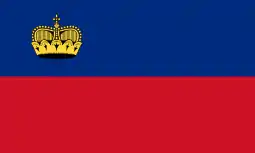Germanic-speaking Europe
Germanic-speaking Europe refers to the area of Europe that today uses a Germanic language.[1] Over 200 million Europeans (some 30%) speak a Germanic language natively. At the same time 515 million speak a Germanic language natively in the whole world (6.87%) (the plurality of whom are speakers of North American English, with approximately 245 million native speakers).

West Germanic languages North Germanic languages Dots indicate areas where multilingualism is common.
History
By the 1st century AD, most of what is today Germanic-speaking Europe was dominated by peoples speaking Germanic languages. These peoples were called Germani by the Romans, and the area they dominated was called Germania. In the preceding centuries, this area had expanded greatly through a series of Germanic expansions. By the 1st century AD, it stretched from the Danube in the south to the North Sea and Baltic Sea in the north, and from the Rhine in the west to beyond the Vistula in the east. The population of this area was however not entirely composed of Germanic peoples. Modern research has determined that much of the area was also inhabited by a non-Germanic indigenous population, who probably spoke a non-Germanic Indo-European language. For this reason, scholars sometimes use the term Germanic-dominated Europe for the region during this time.[lower-alpha 1][lower-alpha 2]
During Late Antiquity, improvements in agricultural methods resulted a massive population expansion in Germanic Europe.[4] During the Migration Period, the area of Germanic Europe was shifted towards the south and west as a result of a series of Germanic migrations.[5] Most notably, there was the Anglo-Saxon settlement of Britain, which placed this region into the orbit of Germanic Europe.[6]
Speakers
- West Germanic (c. 180 million)
- German-speaking Europe (90 million)
- Germans (78 million)
- Austrians (7 million)
- Swiss (4.6 million)
- South Tyroleans (0.3 million)
- Belgians (0.1 million)
- Luxembourgish
- Luxembourgers (0.3 million)
- Dutch (22 million)
- Dutch people (16 million)
- Flemish people (6 million)
- English-speaking Europe (58 million)
- Frisians (0.5 million)
- German-speaking Europe (90 million)
- North Germanic (22 million)
- Swedes (9.5 million)
- Danes (6 million)
- Norwegians (4.7 million)
- Icelanders (0.3 million)
- Faroese (0.07 million)
- Ålanders (0.03 million)
- Finland-Swedes (0.3 million)
Countries
Independent European countries whose population are predominantly native speakers of a Germanic language:
 Austria
Austria.svg.png.webp) Belgium (slightly more than 60% majority concentrated in
Belgium (slightly more than 60% majority concentrated in  Flanders and the German-speaking Community of Belgium)
Flanders and the German-speaking Community of Belgium) Denmark
Denmark Germany
Germany United Kingdom
United Kingdom Netherlands
Netherlands Norway
Norway Sweden
Sweden Iceland
Iceland Ireland
Ireland Liechtenstein
Liechtenstein Luxembourg (mostly and day-to-day use of Luxembourgish, German and French are also used in some areas of life)
Luxembourg (mostly and day-to-day use of Luxembourgish, German and French are also used in some areas of life) Switzerland
Switzerland
| Countries without officially recognised minority | Countries with an officially recognised non-Germanic minority | Countries with a Germanic minority |
|---|---|---|
|
|
See also
| Wikimedia Commons has media related to Germanic nations. |
- Global Leadership § Project GLOBE, where cultural clusters are defined
- Languages of Europe § Romance
- Celtic nations
- Slavs, Slavic languages § Branches
Notes
- "When we talk of Germanic Europe, therefore, we are really talking about Germanic-dominated Europe, and there is no reason to suppose that the entire population of this truly vast area – some of it militarily subdued in the fairly recent past – was culturally homogeneous in terms of belief systems or social practice, or even that it necessarily spoke the same language.[2]
- "In the first century AD, Germanic-speaking groups dominated most of central and northern Europe beyond Rome’s riverine frontiers. The Germani, as the Romans called them, spread all the way from the Rhine in the west (which, before the Roman conquest, had marked an approximate boundary between Europe’s Germanic and Celtic speakers) to beyond the River Vistula in the east, and from the Danube in the south to the North and Baltic Seas... First-century Germania was thus much bigger than modern Germany... With the excision of nationalistic assumptions from the interpretation of literary sources, the history of Germanic-speaking Europe in the Roman period can be rewritten in new and exciting ways... While the territory of ancient Germania was clearly dominated in a political sense by Germanic-speaking groups, it has emerged that the population of this vast territory was far from entirely Germanic... Analysis of river names has shown, however, that there was once in northern Europe a third population group with its own Indo-European language, located between the Celts and the Germani. These people were under the domination of the other two long before Roman commentators reached the area, and we know nothing about them. Much of ancient Germania was also the product of periodic Germanic expansion... But this kind of expansion did not annihilate the indigenous, non-Germanic population of the areas concerned, so it is important to perceive Germania as meaning Germanic-dominated Europe."[3]
References
- Nicholas 2009.
- Heather 2012, p. 6.
- Heather 2007, pp. 52-54.
- Heather 2007, p. 87.
- Heather 2007, pp. 191-192.
- Heather 2012, p. 266, 365.
Sources
- Heather, Peter (2007). The Fall of the Roman Empire: A New History of Rome and the Barbarians. Oxford University Press. ISBN 9780195325416.
- Heather, Peter (2012). Empires and Barbarians: The Fall of Rome and the Birth of Europe. Oxford University Press. ISBN 9780199892266.
- Nicholas, David (2009). The Northern Lands: Germanic Europe, C.1270 - C.1500. Wiley. ISBN 9781405100502.
Further reading
- Bremmer, Rolf H.; Dekker, Kees; Johnson, David F. (2001). Rome and the North: The Early Reception of Gregory the Great in Germanic Europe. Peeters Publishing. ISBN 9789042910546.
- Heather, Peter (2007). "The Transformation of Germanic Europe". The Fall of the Roman Empire: A New History of Rome and the Barbarians. Oxford University Press. pp. 84–94. ISBN 9780195325416.
- Little, Lester K. (Winter 1993). "Romanesque Christianity in Germanic Europe". Journal of Interdisciplinary History. MIT Press. 23 (3): 453–474. doi:10.2307/206098. JSTOR 206098.
- North, Richard; Hofstra, Tette (1992). Latin Culture and Medieval Germanic Europe. E. Forsten.
- Schutz, Herbert (1983). The Prehistory of Germanic Europe. Yale University Press. ISBN 9780300028638.
- Todd, Malcolm (2004). "Germanic Europe". The Early Germans. Wiley. pp. 137–241. ISBN 9781405117142.